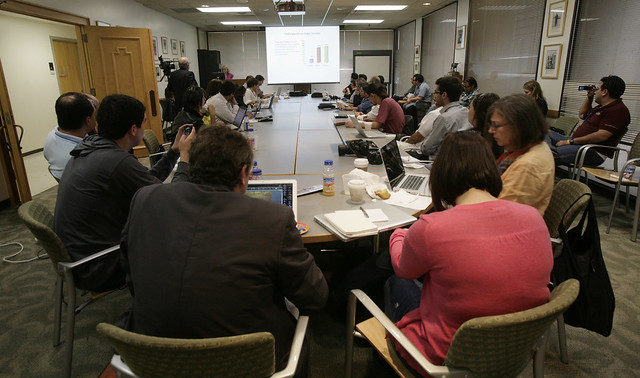April 4, 2011 | Coloquio
Twitter, mobile platfoms and online reader participation among topics discussed at Ibero-American Colloquium
A total of 45 journalists and media executives from Latin America, Spain and Portugal gathered April 3 in Austin for the Fourth Ibero-American Colloquium on Digital Journalism, where they discussed experiences and exchanged ideas about online journalism in the region.

The event, organized by the Knight Center for Journalism in the America, was conducted in Spanish and was a continuation of the 12th International Symposium on Online Journalism, held April 1 and 2.
The day began with an academic research panel. Beth Saad, a professor from the University of Sao Paulo, presented an on-going study about strategies for Twitter use among Brazil’s largest newspapers. Saad said that in general, the media outlets tend to use Twitter to diffuse information, but not to dialogue with their audiences, which in her opinion is a sign that the media is unclear about exactly how to best use Twitter, or how to manage their social media presence.
Saad’s presentation prompted an exchange of ideas among the journalism professionals about what they want out of Twitter, and how to incorporate technologies to better relate to readers. Saad concluded that the media seem to believe that having a Twitter profile is sufficient, which she said is a mistaken approach.
Nuno Vargas, from the University of Barcelona and multimedia consultant for the Portuguese news agency LUSA, spoke about his experiences developing content for mobile platforms. He highlighted the importance of having a clear strategy for which formats and platforms to use when producing news for cell phones or tablet computers. Such a plan helps optimize available resources and, ultimately, develop an information product that is better directed and more well thought out, he said.
Later, University of Piura (Perú) professor Lyudmyla Yezers’ka presented her study about the use of interactive resources in 20 online newspapers in Peru. Her analysis found extensive use of social media (70 percent of newspapers), video (65 percent) and polls (50 percent), which help newspapers get the news out. However, the studied newspapers offered little opportunity for users to provide their own content. For example, only 10 percent of newspapers invited readers to send their own photos, and none allowed users to write their own blogs. Despite this, the researchers found evidence of a dynamism in Peru’s online newspapers during the past five years, with various positive changes, such as their presence in social media, and a greater utilization of multimedia elements.
The colloquium continued with a panel of media professionals who discussed innovations and challenges of using digital media. Filipe Fortes showed a demonstration of Treesaver, a HTML5 platform that allows digital content to be adapted to whatever kind of web browser. Fortes said that currently, browsers — on computers or mobile devices— can do much more, and faster than, than in previous years. HMTL5 language can be used to present web content in multiple ways — from websites to applications — without requiring the user to install anything, and so is more universal and easy to use, Fortes said.
Cuban journalist Karelia Vázquez, a Knight fellow at the University of Stanford, explained the scope of her project that looks to create more fruitful debate in the Cuban blogosphere. According to Vázquez, blogs are one of the most reliable sources of information about Cuba, and her project aims to improve the digital presence of and interaction among Cuban bloggers.
The deputy of the Argentine newspaper Clarín, Miguel Wiñazki, presented the concept of “wanted news,” or pseudo-news the public imposes on the media. Most recently, Wiñazki said, “wanted news” is what governments want, which in the case of Argentina has resulted in growing hostility against the press. This has meant that social networks are not a useful tool to disseminate news or interact with readers, because the media that do not submit to the idea of “wanted news” become the target for a barrage of insults against journalists and the media.
The colloquium concluded with an informal round-table discussion during which Mexican journalists spoke about their experiences covering drug violence and its impacts on journalism. For more information about threats to journalism in Mexico, see this Knight Center map. The situation has prompted various media outlets to develop specific safety protocols, but colloquium participants said the situation changes from one minute to the next, so the same rules can not be applied everywhere.

